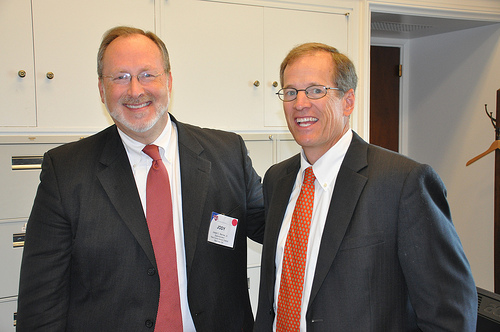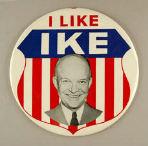Jack's Blog
|
Posted by
Elizabeth K.
on
December 10, 2012
Speaker of the House John Boehner lit the 48th annual Capitol Christmas Tree on the West Front Lawn of the Capitol Tuesday night. The 73-foot tall Englemann spruce made the three week, 5,300 mile journey from White River National Forest in Colorado. Ryan Shuster, an Eagle Scout from Colorado Springs helped Speaker Boehner flip the switch. Decorated with nearly 10,000 low-energy LED lights and 5,000 ornaments handmade by Coloradans, this year’s Capitol Christmas Tree theme is “Celebrating Our Great Outdoors.” Each year, the Christmas tree, dubbed “The People’s Tree” by Tip O’Neill in 1985, is “an emblem of peace for the nation and the world.” The U.S. Air Force Band entertained the audience with “O Christmas Tree” and other Christmas classics. As Speaker Boehner said, “Christmas is not some distant historical event. It is a spirit always bringing us closer to each other and closer to the peace of which the angels sang.” From all of us at Congressman Kingston’s office, we wish you a happy and safe holiday season filled with family and friends.
Posted by
on
December 07, 2012
In the negotiations over the fiscal cliff, we have heard a lot from President Obama about raising taxes. We know that the President wants to increase taxes but despite all the talk about a “balanced approach” we have yet to see him propose any real spending cuts. Any such offer would most certainly include substantive spending cuts. That means spending less, not exploiting budget tricks to satisfy phony accounting.
Posted by
Chris
on
October 05, 2012
1. 4.1 Million Fewer Jobs than Projected: In January 2009 the Obama Administration forecast there would be 137.6 million jobs in December 2010. Instead there were 130.3 million jobs in December 2010. Even 21 months later in September 2012, there are just 133.5 million jobs – 4.1 million fewer than the Administration’s forecast for late 2010.
2. Slower Jobs Recovery than during the Great Depression: This is the only “recovery” since World War II when jobs lost in the recession had not been recovered by this point. In fact, the recent pace of job creation during the “Obama recovery” has been slower than during the Great Depression. 3. Less Full Time Work: Since January 2009 the number of full-time employees has fallen by over 600,000 while part-time employment has grown by almost 1.4 million. This means part-time workers account for all of the net employment growth in the Obama years – the opposite of what Democrats predicted when they said their stimulus plan was “likely to move many workers from part-time to full-time work.” 4. Manufacturing Jobs Down: Since January 2009 over 600,000 manufacturing jobs have been eliminated, the opposite of the Administration’s projected increase of 408,000 manufacturing jobs due to their trillion-dollar stimulus. 5. Ten Times More New Dropouts than New Employees: During the Obama Administration, the number of people not in the labor force has grown by 8.2 million while total employment has grown by less than 800,000. This means that during the Obama years new workforce dropouts have outnumbered new employees by 10 to 1. 6. Far Higher Unemployment Rate than Projected: September’s 7.8% unemployment rate remains far above the 5.5% rate the Administration predicted for this month in their January 2009 report on the projected effects of stimulus. Democrats actually predicted unemployment would fall to 7.8% in September 2009 – a full three years ago. 7. Real Unemployment Is Almost 11%: If the unemployment rate included the “invisible unemployed” (discouraged workers who dropped out or never joined the workforce), the September 2012 unemployment rate would be 10.9%:
8. More Unemployed Now than When Economy Was in “Free-Fall”: In September 2012 there were 12.1 million officially unemployed workers. That’s 39,000 more than when President Obama took office in January 2009 – when the Administration said “we were in economic free-fall.”
9. Two Million More Long-term Unemployed: In September 2012 there were 4.8 million long-term unemployed (that is, for over six months) – over two million more than when President Obama took office in January 2009. 10. Economic Misery up 80%: The “Obama Misery Index” shows that unemployment and debt have risen by a combined 80% since the start of the Obama Administration. Courtesy House Ways & Means Committee
Posted by
Chris
on
September 17, 2012
In case you missed it, Jack appeared on WTOC to discuss the attacks against Americans abroad and the dangers posed to our military and national security by sequestration. You can read more about both these subjects in this week's e-newsletter.
div>
Posted by
Chris
on
September 01, 2012
Labor Day is a wonderful holiday. It provides us a chance to celebrate all that summer had to offer while looking forward to fall. If we are lucky, it gives us a chance to spend time with our family and friends, cook out, and celebrate the start of football season (Go Dawgs!). The real meaning of Labor Day, however, is taking a moment to celebrate the American worker. Throughout our history, the American workforce has led the world in innovation and productivity. We have dreamed up some of the greatest inventions and created the supply chain to spread them all over the world. America gives everyone – regardless of your past – the opportunity to earn a livelihood, provide for your family, and, if you’re lucky, the chance to give a hand up to the next generation so they may seek an even better life. Unfortunately, America’s economy is puttering right now and is failing the American worker. A report this week from the Bureau of Economic Analysis found that economic growth slowed for two consecutive quarters, making this the weakest economic recovery since World War II. Remember when the Obama Administration campaigned for his trillion dollar “stimulus”? They promised unemployment would never rise above 8 percent and millions of jobs would be created by the end of 2010. As of last month, there are still 4.4 million fewer jobs than the Administration forecast for December 2010 and unemployment has been above 8 percent for 42 straight months, marking the longest period of high unemployment since the Great Depression of the 1930s. While some in Washington focused on a passing a misguided health care law, the rug was being ripped out from under American workers. Today there are 1.5 million fewer full-time workers than when President Obama took office. Millions of Americans only have work because they have been forced to shift from full-time to part-time employment, often lacking benefits or the ability to support a family. The economy has become so bad that many are giving up looking for work all together. Under President Obama, total employment has increased by a net of just 33,000 new employees. In that same time, the number of people no longer in the labor force has grown by 7.8 million. That means that during the Obama years, labor force drop outs outnumbered new employees 237 to 1. Even worse, those who have been able to maintain their jobs see their paychecks falling behind inflation as prices rise while wages stay stagnant or decline. I hope this Labor Day provides everyone with an opportunity to reflect on this state of the American economy and the American worker. We face great challenges but America has never been one to back down before. It is not too late to abandon the failed policies that have made a bad economic situation worse. It’s not too late to put a halt to overly-burdensome and misguided government regulations. We should be able to come together and agree that regulators should work with well-intentioned businesses rather than using the law to exploit inadvertent mistakes. It’s not too late to create jobs and bring down the cost of gasoline by developing America’s energy resources. An all-of-the-above energy platform would harness America’s energy potential both in conventional means and renewable resources. It’s not too late to replace our misguided tax code with one that works for the American economy by making it fairer, flatter, and more conducive to growth. In each of these areas the House has acted: calling for a review of regulations and repeal those that yield little benefit while they inflict much economic damage; voting to end President Obama’s de facto energy moratorium and to expand safe development of our resources; and laying the ground work to fast track fundamental tax reform. In each of these areas, we welcome the President and the Senate to join us. We also welcome them to act on any of the more than thirty bipartisan jobs bills passed by the House which await Senate action. More than any holiday, honoring the American worker today starts with coming together to reignite the American economy and revive the American dream. ---
Posted by
Morgan R. & Marjie D.
on
July 30, 2012
During the children's three day camp, they began their days with an educational lesson about the history of stamp collecting. Children engaged in games such as stamp scavenger hunters. During the hunt they searched through the many free stamps, provided by the exhibit, in hopes to find what they were scavenging for.
It is amazing how tiny stamps can be the starting grounds to a whole educational lesson on a variety of topics, such as wildlife or the history of past U.S. presidents. It allows the kids to have colorful images of real-life stories. Stamp Camp USA encourages children to not only learn, but also engage in teamwork and develop leadership skills. I was very impressed by the Congressional stamp exhibit and hope it continues to enrich children’s and adult’s lives. Morgan and Marjie are rising seniors at the University of Georgia who are currently interning in Jack's Washington, D.C. office.
Posted by
Jack
on
July 29, 2012
Posted by
Chris
on
July 19, 2012
Dr. Joseph Barrow, Superintendent of Ware County Public Schools, poses with Congressman Jack Kingston (R-GA) after a meeting in Kingston's Washington, D.C. office. During their meeting, Barrow and Kingston discussed federal education programs and the challenges in education today.
Posted by
Chris
on
July 15, 2012
Last week, the House voted on a bipartisan basis to repeal President Obama’s misguided health care law. I voted in favor of repealing the law for five reasons. First, it increases the cost of care. The non-partisan Congressional Budget Office found that the law will actually increase health insurance premiums for families by $2,100, in direct contrast to the President’s campaign trail promise that his plan would reduce premiums by $2,500. Second, it would cause twenty million Americans to lose their employer-sponsored health insurance according to the non-partisan Congressional Budget Office. The Obama Administration’s own Department of Health and Human Services estimates that 80 percent of small businesses and 64 percent of large businesses will discontinue offering health insurance to their employees. Third, it interferes in the doctor-patient relationship. The law creates 159 new boards, offices, and panels within the federal government to make health care decisions for individuals. Fourth, it piles more debt on our children and grandchildren. At a time when we already borrow 40 cents on every dollar the government spends, the law would add another $1.8 trillion over the next decade. We do not have the money. Fifth, it is a job killer. The Congressional Budget Office estimates that nearly 800,000 jobs will be lost because of Obamacare. As last week’s jobs report made clear, we cannot afford to further erode the employment situation. While I remain committed to repealing this misguided law, we must work to reform the underlying problems in our health care system. As opposed to the divisive politics and underhanded tactics used to enact it, we should come together and put our best ideas forward to replace the law. To this end, I have cosponsored reforms that would: Allow Interstate Competition for Health Insurance Expand Health Savings Accounts Increase Access for Patients with Pre-Existing Conditions Level the Playing Field for Purchasing Health Insurances Permanently Prohibit Taxpayer Funding of Abortion
Posted by
Phillips W.
on
July 13, 2012
In a few short months, America’s television and radio waves will be overrun with publicity for the 2012 presidential election. Every time Americans flip on the news or a sports broadcast, I can almost guarantee that we will see President Obama and Governor Romney going after each other in carefully crafted commercials. The Internet won’t be spared, either—Facebook pages, Twitter feeds, and even ESPN articles will be hit with a wave of campaign advertising. For better or for worse, the rise of technology has transformed the way presidential campaigns are conducted.
Today, I got a glimpse of what election years were like before the Information Age at the Library of Congress’s presidential campaign memorabilia display. It was very different to see such an emphasis on print advertising—a medium that has become marginalized. Romanticized photographs or portraits highlighted catchy slogans like “Tippecanoe and Tyler, Too” (William Henry Harrison) and “I Like Ike” (Dwight Eisenhower). Though flyers and posters are still around, some methods have fallen by the wayside completely. Songbooks and sheet music used to by common on the campaign trail, and the LoC’s collection included colorful tunes like “Everything Will be Rosy with Roosevelt”, “We’ll do it with Dewey”, and my personal favorite, “Turn the Rascals Out”. As frustrating as they can be and as never-ending as they seem, modern campaign tools, like TV and the Internet, are more beneficial for both the candidate and the electorate. A nominee can get out his message quickly, and voters can debate and fact-check almost as fast. However, the LoC’s exhibition was a great opportunity to see how history’s leaders presented themselves. It was also a reminder that today’s invaluable campaign instruments will someday be viewed by an intern as artifacts in a museum. Phillips W. is a rising sophomore at Clemson University. He is a summer intern in Jack’s DC office. |






 St. Simons Island
St. Simons Island
 Valdosta State University
Valdosta State University
 Broxton Rocks
Broxton Rocks
 Jekyll Island
Jekyll Island




